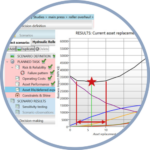
…that ensures that decisions are value-based and provide consistency, transparency and governance in determining what is worth doing, why and when.
The SALVO Process is an end-to-end process for decision-making in six fundamental steps, comprising a ‘top-down’ targeting of the most important and valuable issues and opportunities to be addressed, and a ‘bottom-up’ evaluation, justification, optimal timing and program integration of the most appropriate actions or solutions.
The steps are illustrated in the “SALVO Smiley”. Full process mapping and best practice guidance was developed for each of these steps

At the heart of the SALVO Process lies the navigation of competing stakeholder interests and business priorities to determine the optimal compromise (best value solution). Here, SALVO builds on the work of the European MACRO Project (EU1488) to ensure comprehensive coverage of business drivers and the trade-off’s, using the ‘Shamrock diagram’. Intrigued? Click below to find out more.

Step 1 recognises that an asset portfolio is often large and very diverse, and that competing priorities will often be unclear and volatile. So asset management strategies need to be both flexible, scale-able, customization and agile. A single strategy or a single ‘solution’ is unlikely to have universal application. Even assets of an identical type will have different criticalities within different systems or functional locations; they may also be in different condition or health, have different ages, accessibility for maintenance and other features, any or all of which can influence what should be done, and when, to manage them.
So, instead of a ‘one size fits all’ approach (such as a standardised maintenance programme for each asset type), the first priority is to identify the asset groupings or sub-groupings that can and should share a common strategy through their commonality of type and functional role, age, health etc. This is not just risk and ‘criticality’ analysis – SALVO has researched and revealed over 40 potential factors that can be used to distinguish between asset needs; sorting out both the importance of asset management attention and the urgency of such attention.
Step 1 ensures that the right problems (or improvement opportunities) are identified, with the correct priority for investigation.

Step 2 drills down into these issues identified in Step 1, to ensure that the problems/ opportunities are genuinely understood and root causes are addressed. In many current cases, short-termism and a ‘patch and continue’ habit is found to result in recurring problems and missed opportunities.
SALVO processes identify and capture the ‘why’ as well as the observed symptoms and manifestations of the aging assets problem.

Triggers the identification of potential interventions or asset management options. And SALVO innovation has broadened this consideration a great deal. Failure mode, effects and criticality analysis (FMECA), reliability-centred maintenance (RCM) and risk-based maintenance (RBI) methods, for example, only consider a small range of technical interventions (proactive/ design change, predictive, preventive and corrective maintenance options) to control risks.
SALVO has identified over 50 options that might be considered, including a number of non-asset/technical solutions such as insurance and operator competency or incentives. Stimulation of such lateral thinking reveals potentially high value ideas that would not necessarily have emerged from traditional strategy development tools.

Step 4 is a big area of SALVO innovation, it provides the objective business case evaluation and optimised timing of the different intervention options. It involves a toolbox of methods, since the cost/benefit appraisal of a design modification, or an operator training course, is very different to the evaluation of optimal inspection intervals or asset replacement timing. And, as the prior MACRO Project found, the level of sophistication worth applying is dependent upon the criticality and complexity of the individual cases (see below left).




Finally, Step 6 assembles the total asset management programme of optimized strategies to see the combined Capex / Opex costs, resources, and performance and risk implications (including residual, justified risks).
In a cost- or resource-constrained environment, this enables the least-valuable or least timing-critical tasks (having the least consequence of deferment) to be identified.
Step 6 ensures, and demonstrates that the best value combination of things are funded and planned to be done at the right time. Exploring different global scenarios, sensitivity testing. Change management is also enabled in the programme with an easy ‘drill-down’ into the component activities for changes and for ‘re-shuffling the deck’ of what is worth doing, and when.